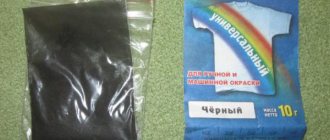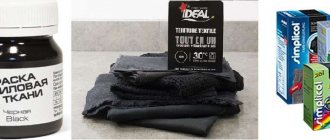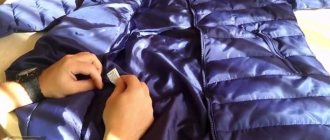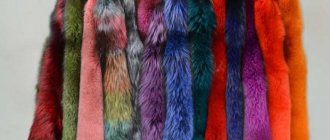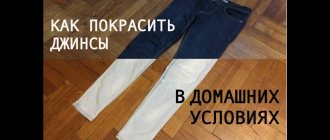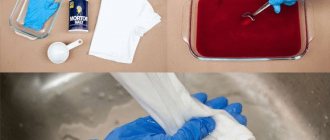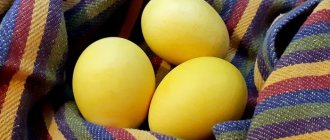Snow-white tulle is the most popular window decor. The main reasons to dye tulle:
- desire to change the interior;
- the need to give a fresh look to a curtain that has lost its snow-whiteness over time.
Existing whitening products solve the problem partially and not for long.
Gray or yellowed tulle can be replaced with a new one, or you can give it a second life by repainting it in a new color.
Fabric dyeing is an affordable and widespread service. Curtains can always be entrusted to specialists. However, painting yourself has undeniable advantages:
- saving money and time (the process is not labor-intensive; as a rule, it requires much less time than delivery and waiting);
- the ability to accurately select the desired color and its intensity.
How to paint tulle at home
You can give tulle almost any color yourself. When choosing a dye, it is advisable to weigh the strengths and weaknesses of each. All colors can be divided into chemical and natural.
Chemical dyes
Chemical dyes include potassium permanganate and numerous aniline dyes, including brilliant green solution (zelyonka). They are very popular, their advantages:
- wide color palette;
- ease of use compared to natural ones.
The disadvantages include:
- less gentle treatment of fabric compared to natural ones;
- the presence of a pungent odor for some, sometimes long, time after painting.
Natural materials used to dye tulle
There are not many natural colors, but their shades are quite noble, many of them are universal. Coloring can be done with tea, coffee, herbal infusions, juices of numerous vegetables and fruits, the most popular being beet juice. The advantages of such dyes:
- gentle treatment of fabric;
- the smell, if it remains, is not sharp and dissipates quickly.
Flaws:
- limited color selection;
- more time-consuming to prepare.
Choosing a dye
After the preparatory stage, you need to decide what color you want to get the textile product. A large selection of aniline dyes sold in retail chains will help you dye nylon mesh or dense fabrics in the desired color. Choose a product that matches the material and intended color.
It is not difficult to color curtains and tulle with purchased dyes; the main thing is to strictly follow all the steps prescribed in the instructions.
But not only aniline agents change the color of window curtains. You can color roller blinds and all other window treatments using available substances that can change the shade of the fabric. This is easy to do using:
- Tea leaves.
- Brilliant greenery (zelenka).
- Potassium permanganate.
- Onion peel.
- Juice of some products (beets, blueberries, blackberries, spinach).
- Coffee.
Preparing a tulle curtain for painting
The preparation process is practically no different from regular washing. The washing temperature should not exceed 30 °C for synthetic fabrics and 40 °C for natural ones.
Important! Additional attention should be paid to:
- shaking out the curtain before washing so that there are no small specks left that can prevent uniform coloring;
- gentle spin, it is better not to squeeze at all, let the water drain: creases will also prevent the uniform distribution of color.
Preparing the fabric
Before painting window curtains, you need to prepare the product. After removing the window curtains, you need to carefully knock them out to get rid of dust and foreign particles. Warm water and detergent are what you will need for this step. The washing solution should not be made too concentrated, otherwise it will be difficult to rinse later. It is advisable to use hand washing or gentle cycle in a washing machine.
Warm temperature conditions (no higher than 40 degrees) are suitable in order not to spoil the fabric and at the same time. To achieve excellent results, repeat the washing and rinsing procedure several times.
High-quality dyeing of tulle at home can only be done on well-washed fabric. Under no circumstances do the following:
- twisting;
- strong mechanical impact;
- twisting push-up.
This will damage the fabric, and painting the curtains will not be a positive event, but a disappointment.
How to dye tulle at home
After washing the curtain, we begin preparing the dye. The methods differ depending on what you choose.
Aniline dyes
Quite comfortable to use. As a rule, you need to dilute a certain amount of color in the appropriate amount of water, stir, soak, and rinse.
Important! Before use, you must carefully study the instructions and act strictly according to them! Failure to comply with the proportions can irreversibly damage the tulle.
Zelenka
Zelenka does not completely dissolve immediately, so it is preferable to first prepare a concentrated aqueous solution in a glass. For this:
- drop a small amount of greenery into a glass;
- fill with water and leave for 5–10 minutes;
- stir;
- If you are not sure that the particles have completely dissolved, it is better to strain it before adding it to a bowl of water.
In a basin, mix warm water and a solution of brilliant green. If you do not want to dilute the aqueous solution separately, give the brilliant green additional time to completely dissolve directly in the basin.
Attention! The concentration depends on the required shade. If you are unsure how brightly green you want the fabric to turn, you should start with a pale solution. If you want to get a brighter color, the procedure can always be repeated with more dye.
Important! The curtain is placed only in a homogeneous aqueous solution of brilliant green; if you want to increase the concentration, you need to remove the curtain from the basin, add and stir the color, put the curtain in the basin.
To ensure uniform coloring, the tulle must be rotated. Having received the desired color, rinse.
Potassium permangantsovka
Painting lilac with potassium permanganate is similar to painting with brilliant green:
- dissolve a small amount of potassium permanganate in a glass of water;
- leave for 5 minutes, stir;
- pour warm water into the basin;
- We also filter a concentrated solution of potassium permanganate in an amount sufficient for the desired shade;
- stir;
- soak the tulle;
- To ensure uniform coloring, constantly turn it over for 15 minutes;
- rinse with cool water.
Tea or coffee
A natural dye made from tea or coffee will make a curtain brown or cream:
- Brew 1–2 tablespoons of tea or coffee with boiling water, the amount of boiling water is not important (usual cup, jar), the color will be diluted;
- After 7–10 minutes, strain;
- pour water and brewed tea or coffee into a basin, mix, the temperature in the basin should be approximately 30 °C;
- soak the tulle and constantly turn it;
- Having received the desired color of the curtain, rinse it with cool water.
Beetroot
Beetroot can dye fabric a pleasant beetroot color; for this you will need:
- thoroughly wash or peel the beets;
- we cut it and fill it with vodka, depending on the expected color saturation, the proportions can be from 0.5 to 1 liter of vodka per 1 kg of beets;
- cook the beets in this solution until tender (check with a knife);
- filter the solution;
- pour warm water and strained beet broth into a basin;
- soak the curtain, don’t forget to turn it over;
- When the desired shade is achieved, rinse.
Recommendations for dyeing clothes and tulle:
- The most important and main advice. Before you start directly painting clothes, weigh the pros and cons. Amateur painting is always a risk.
- Know the composition of the fabric, because the entire painting result depends on the composition of the fabric:
- if the fabric is natural, for example: cotton, linen, denim, then, as a rule, dyeing goes well;
- if the fabric is mixed, the color will come out a little paler, for example, it will not be blue, but light blue.
- if the fabric is 100% synthetic, there is a very high risk that the fabric will not dye at all, because with synthetic fabrics, the paint flows off like cellophane, and the product will remain exactly the same shade as before dyeing.
Important! Please note that, unfortunately, at the moment there are more and more cases when the composition that is written on the label does not coincide with reality.
- Decide on a color. We recommend dyeing in colors that are slightly darker than the original shade of the fabric. For example, blue is best painted blue or dark blue. Also, do not forget to take into account the original shade of the item. The ideal option is if they are similar colors. But if you dye white jeans black, you will end up with gray or dark gray, but not black.
- Only judge the final shade on a thoroughly dried dyed item, because wet items are always darker.
- If color is very important to you, dye a test piece of fabric that will be the same in composition, dry it and look at the result.
- If you don’t like the shade of the paint you prepared, it’s better not to risk it. In industrial conditions, shades of paint are tested a large number of times, achieving the required color. At home, you only have 1 try.
- Paint only with gloves on. Wear gloves before opening the paint package if you decide to use an industrial solution rather than the options we offer. When working with medical solutions, also do not ignore gloves, so as not to think later about how to wipe off brilliant green or potassium permanganate from the skin.
- Paint items according to the instructions written on the packaging when using industrial dyes.
Dyeing tulle in the washing machine
Painting with a washing machine has its advantages:
- relief of manual labor;
- more intensive mixing, resulting in uniform coloring.
There are disadvantages:
- as a rule, additional time is required;
- risk of slight staining of white items during subsequent washing.
The principle of painting is similar to manual:
- shake out, pre-wash, but do not wring;
- dilute the dye according to the instructions (special products) or according to recommendations (folk);
- pour the concentrate into the drum;
- we put the curtain there;
- select the washing mode without spin;
Important! Machine wash only without pre-soaking, otherwise the color may be uneven.
- We take out the curtain and start the machine without laundry to rinse.
Tips for caring for the product
In order for painted tulle to please its owners for a long time with its updated look, it is worth following the recommendations for proper care of it:
- do not add too much powder during washing - this harms the structure of the fabric and washes out the paint faster;
- When washing items for the first time, add color fixative to the water (sold in hardware stores);
- Wash thin fabric by hand or on the most delicate cycle, otherwise it may be damaged, or place it in a special bag when washing;
- Do not wash tulle in hot water - use only warm or even cold water;
- Do not iron the tulle with a hot iron, as it may turn yellow.
Using inexpensive dyes, you can completely transform the look of curtains, giving them a new color, brightness and richness. The process will not require much time, but will allow you to fully express your taste and imagination.
A few more ways
If you want something new in the interior, you can paint tulle in interesting ways:
- You can use flowers to make the tulle yellow. It is important that they are yellow. Not only dandelions are suitable, but also calendula. The solution must be diluted in a manner similar to the methods described above.
- To make the tulle orange, you need to use carrots or onion peels as a dye.
- The green color will be achieved not only by brilliant green, but also by sorrel stems and spinach leaves.
- The tulle will turn black if you use blackberries as a coloring component.
It’s easy to dye tulle at home; just select a dye, soak the fabric, rinse and dry the product. Let your interior delight you with fresh color after the tulle has been painted in the desired tone.
